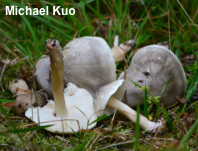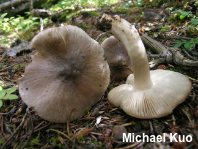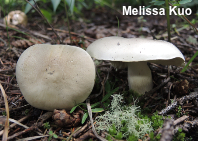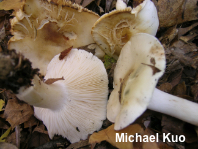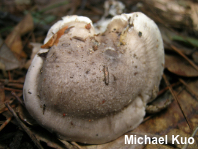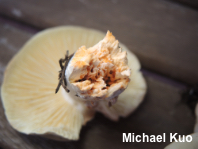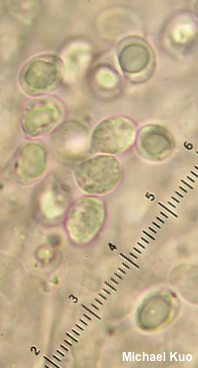| Major Groups > Gilled Mushrooms > Pale-Spored > Tricholoma > Tricholoma saponaceum |

|
Tricholoma saponaceum [ Basidiomycota > Agaricales > Tricholomataceae > Tricholoma . . . ] by Michael Kuo By the strictest definition currently available (Christensen & Heilmann-Clausen 2013), Tricholoma saponaceum is a European species, originally described from Sweden, with a gray to dark olive cap, associated with hardwoods—and possibly, but not certainly, with conifers as well. The flesh in the stem base turns reddish to orangish, and the odor is peculiar and vaguely reminiscent of soap. The species is variable in several features: the cap color ranges from gray to olive (but not yellow, yellow-green, or flat-out green); the stem ranges from smooth to finely scaly. Christensen & Heilmann-Clausen separate two European species from the saponaceum group: Tricholoma rapipes (cap yellow to green, association with spruce) and Tricholoma sudum (cap brown, association with pines, mealy odor, and larger spores). The true, European Tricholoma saponaceum is featured in the top illustration to the right, which represents a beech-associated collection from the Italian Alps. As for Tricholoma saponaceum in North America . . . well, I once had a frustrated, banjo-playing literature professor who screamed at the class: "You can't fill a thimble with 'culture.'" His point was that the definitions of "culture" the class was producing were all pretty silly, and unlikely to lead to a productive discussion. Now, more than 30 years later, it's my turn: you can't fill a thimble with "Tricholoma saponaceum" on our continent. In our North American litearture Tricholoma saponaceum is generally treated as a medium-sized species with flesh that turns reddish to orangish in the base of the stem, a soap-like odor, and, well, pretty much any cap color you want and potential mycorrhizal association with any tree on earth. Descriptions of the species allow the cap color to range from gray to brown to yellow to green, while associated trees range from oaks in warm climates to high-elevation and boreal conifers. Clearly, there is more than one species involved! According to Christensen & Heilmann-Clausen "[i]t seems evident from illustrations on the internet and from ITS-sequences deposited in GenBank that the section [of Tricholoma saponaceum and close relatives] is also quite diverse in the Americas." Here I have described and illustrated my European collection, along with North American collections that approach the European species in featuring gray to brown caps. But since the collections range in habitat from tanoak forests in California to high-elevation spruce-fir forests in Colorado to Midwestern oak-hickory forests, you can bet that several species are involved. The saponaceum group in North America is a mycology graduate student's dissertation waiting to happen! Description: Ecology: Mycorrhizal with hardwoods or conifers; growing alone, gregariously, or in clusters; summer and fall (or in winter and spring in warmer areas); widely distributed in North America as a species group (see discussion above). The illustrated and described collections are from Italy, California, Colorado, and Illinois. Cap: 4–10 cm across; convex, becoming broadly convex or nearly flat, often with a central bump; dry; gray, copper colored, or brownish; usually with a paler margin and a darker center; fairly bald, or with minute, appressed fibers. Gills: Attached to the stem or notched; close; short-gills frequent; whitish; sometimes developing yellowish edges with age. Stem: 5–10 cm long; 1–2 cm thick; more or less equal; bald, or with silky appressed fibers, or with varying degrees of tiny grayish scales; dry; white to gray or yellowish; sometimes stained pinkish to orangish near the base; basal mycelium white. Flesh: Whitish and unchanging when sliced, except in the stem base, where it is usually pinkish to orangish (sometimes the color takes quite a while—even overnight—before manifesting). Odor and Taste: Taste mealy or not distinctive; odor like soap, or mealy, or not distinctive. Chemical Reactions: KOH negative on cap surface. Spore Print: White. Microscopic Features: Spores 4–9 x 3–6 µm; ellipsoid; smooth; hyaline in KOH; inamyloid. Lamellar trama parallel. Basidia 4-sterigmate, occasionally 2-sterigmate. Hymenial cystidia not found. Pileipellis a cutis; elements 3–6 µm wide, smooth, hyaline in KOH. Clamp connections present. REFERENCES: (Fries, 1818) Kummer, 1871. (Saccardo, 1887; Kauffman, 1918; Smith, Smith & Weber, 1979; Ovrebo, 1980; Arora, 1986; Phillips, 1991/2005; Lincoff, 1992; Shanks, 1994; Evenson, 1997; Roody, 2003; Roody, 2003; McNeil, 2006; Miller & Miller, 2006; Trudell & Ammirati, 2009; Bessette et al., 2013; Christensen & Heilmann-Clausen, 2013; Desjardin, Wood & Stevens, 2015; Evenson, 2015; Cripps, Evenson & Kuo, 2016; Siegel & Schwarz, 2016; Heilmann-Clausen et al., 2017; Sturgeon, 2018.) Herb. Kuo 01150503, 11020502, 09010606, 10111413, 08141511. Herb. DBG RMNP 2008-131, 2008-232. This site contains no information about the edibility or toxicity of mushrooms. |
© MushroomExpert.Com |
|
Cite this page as: Kuo, M. (2019, September). Tricholoma saponaceum. Retrieved from the MushroomExpert.Com Web site: http://www.mushroomexpert.com/tricholoma_saponaceum.html |
